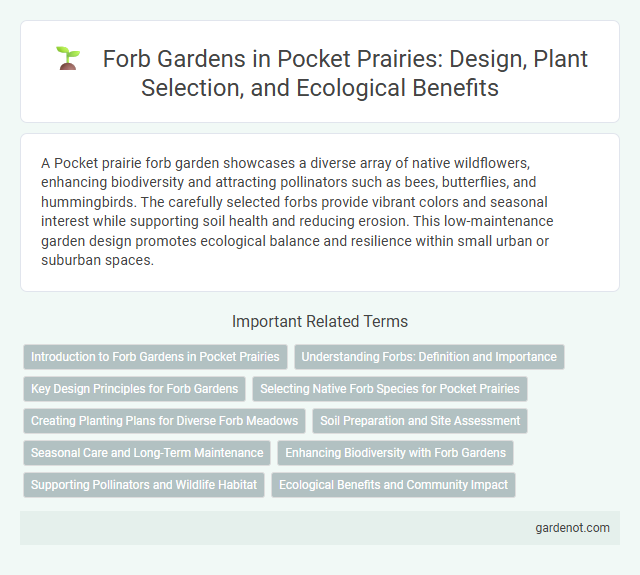A Pocket prairie forb garden showcases a diverse array of native wildflowers, enhancing biodiversity and attracting pollinators such as bees, butterflies, and hummingbirds. The carefully selected forbs provide vibrant colors and seasonal interest while supporting soil health and reducing erosion. This low-maintenance garden design promotes ecological balance and resilience within small urban or suburban spaces.
Introduction to Forb Gardens in Pocket Prairies
Forb gardens in pocket prairies feature diverse herbaceous flowering plants that enhance biodiversity and support pollinators like bees and butterflies. These gardens contribute to soil health by improving nutrient cycling and water retention through deep-rooted forb species. Integrating forbs in pocket prairies creates vibrant habitats that promote ecological resilience and natural pest control.
Understanding Forbs: Definition and Importance
Forbs are herbaceous flowering plants that are broad-leaved and non-woody, playing a vital role in pocket prairie ecosystems by enhancing biodiversity and providing essential habitat for pollinators and wildlife. Their diverse species contribute to soil health through nutrient cycling and erosion control while supporting native insect populations critical for pollination. Incorporating forbs in a pocket prairie fosters ecological balance and resilience, making them indispensable for sustainable garden design.
Key Design Principles for Forb Gardens
Forb gardens emphasize biodiversity, using a variety of native forb species to enhance ecological balance and support pollinator habitats. Design principles prioritize soil health by incorporating deep-rooted perennials that improve soil structure and nutrient cycling. Strategically spacing plants ensures optimal sunlight exposure and reduces competition, promoting healthy growth and resilience against pests.
Selecting Native Forb Species for Pocket Prairies
Selecting native forb species for pocket prairies ensures ecological compatibility and supports local pollinators by providing essential nectar and habitat. Prioritizing species such as Echinacea purpurea, Solidago canadensis, and Asclepias tuberosa promotes biodiversity and resilience against invasive plants. Native forbs contribute to soil health and water retention, enhancing the overall sustainability of pocket prairie projects.
Creating Planting Plans for Diverse Forb Meadows
Creating planting plans for diverse forb meadows involves selecting a wide range of native wildflowers that support local pollinators and enhance biodiversity. Emphasizing species with varying bloom times, growth habits, and soil preferences ensures a resilient and visually dynamic pocket prairie. Incorporating nitrogen-fixing forbs like lupines and providing structural diversity with taller asters and shorter goldenrods optimizes ecological benefits and habitat quality.
Soil Preparation and Site Assessment
Soil preparation for a forb garden in a pocket prairie involves thorough site assessment to ensure optimal growing conditions. Begin by analyzing soil texture, pH, and nutrient levels to select appropriate native forb species that thrive in local conditions. Removing invasive plants and loosening compacted soil enhances root penetration and water infiltration, promoting healthy forb establishment.
Seasonal Care and Long-Term Maintenance
Forb gardens in pocket prairies require seasonal care such as timely pruning, weed control, and mulch application to promote healthy growth and flowering. Monitoring soil moisture and adjusting watering schedules ensure resilience during dry spells and prevent root rot in wetter seasons. Long-term maintenance involves periodic soil testing, rotational planting to maintain biodiversity, and managing invasive species to sustain ecological balance and soil health.
Enhancing Biodiversity with Forb Gardens
Forb gardens play a crucial role in enhancing biodiversity within pocket prairies by providing diverse native flowering plants that support pollinators such as bees, butterflies, and hummingbirds. These gardens improve soil health through varied root structures and increase habitat complexity, promoting a balanced ecosystem. Incorporating a wide range of forb species boosts resilience to pests and environmental stress, fostering sustainable prairie restoration.
Supporting Pollinators and Wildlife Habitat
Forb gardens in pocket prairies play a critical role in supporting pollinators such as bees, butterflies, and hummingbirds by providing diverse nectar sources throughout the growing season. These native herbaceous flowering plants create essential wildlife habitat, offering shelter and food for insects, birds, and small mammals. Incorporating a variety of forb species enhances biodiversity, promotes ecological resilience, and improves overall ecosystem health in urban and rural landscapes.
Ecological Benefits and Community Impact
Forb gardens enhance biodiversity by providing critical habitats and food sources for pollinators, birds, and beneficial insects. These gardens improve soil health through nutrient cycling and erosion control, contributing to sustainable urban ecosystems. Community engagement grows as local residents participate in planting and maintaining forbs, fostering environmental stewardship and educational opportunities.
Forb garden Infographic

 gardenot.com
gardenot.com